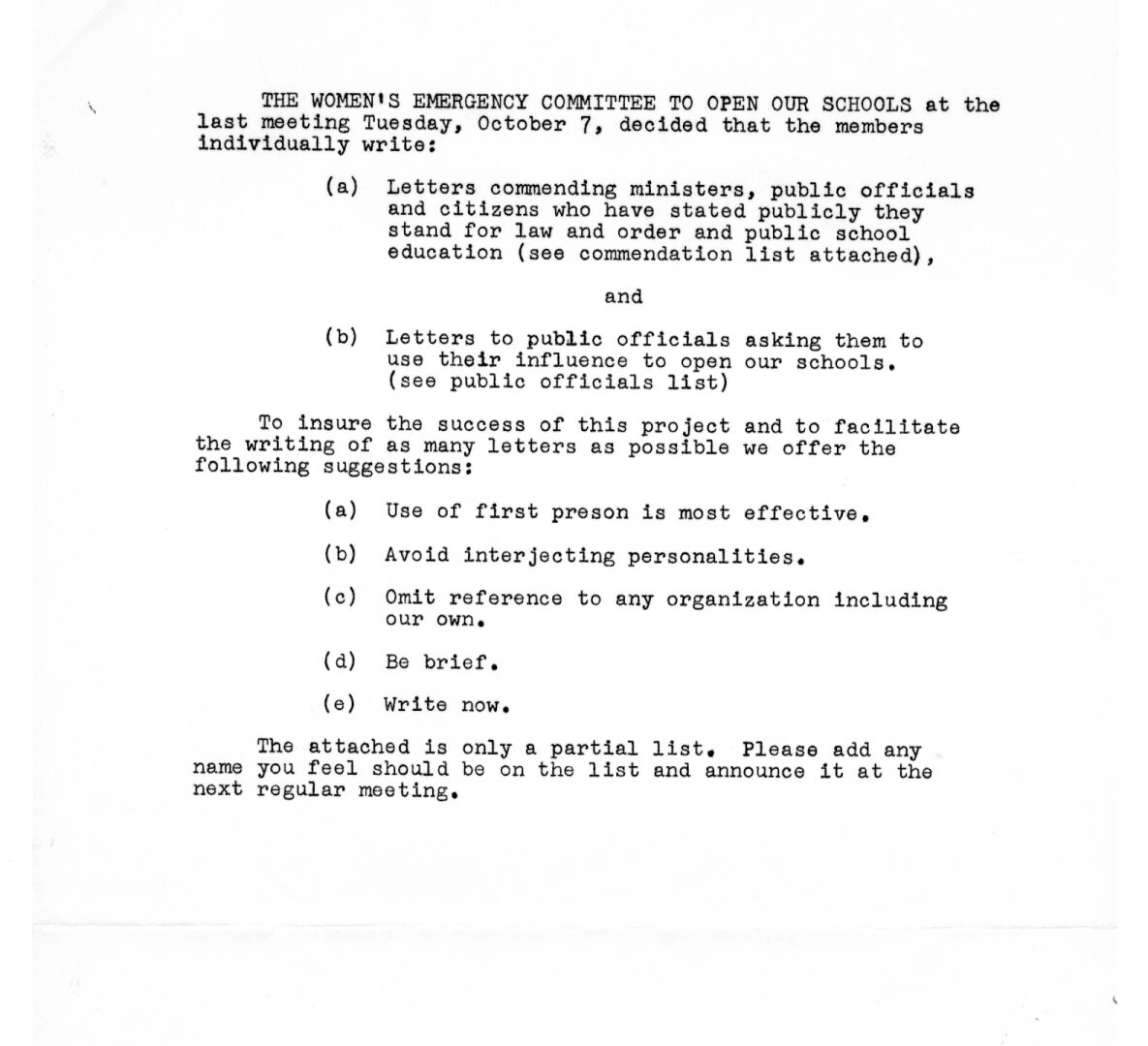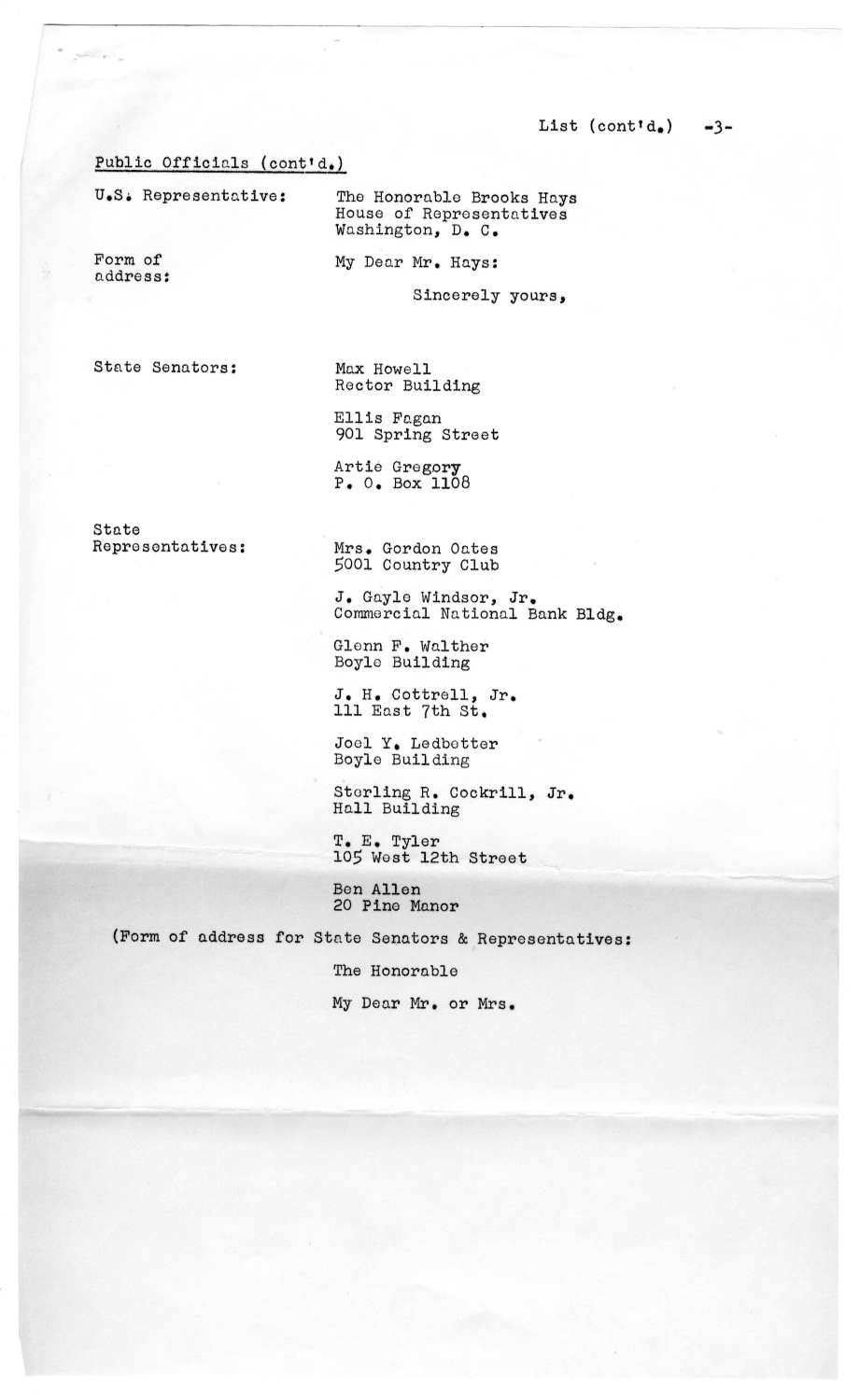Women’s Emergency Committee
Introduction
In 1955, following Brown v. Board of Education, the Little Rock school board accepted a plan of gradual integration presented by superintendent Virgil Blossom. According to the plan, Little Rock schools were to begin the integration process in the fall of 1957. However, when nine African American students enrolled in Central High appeared in front of their new school on September 4, 1957, they were met by a white angry mob and the Arkansas National Guard. Governor of Arkansas Orval Faubus called the latter not to protect the black students’ constitutional right to an equal education but to block them from entering the school building. In response to this violation of federal laws, President Dwight Eisenhower federalized the Arkansas National Guard and ordered them to support the integration and protect the African American students. The students are known today as the Little Rock Nine.
Although after Eisenhower’s intervention the Little Rock Nine could enter the school, the crisis was far from over. One outcome of the events was Governor Faubus’s decision to close high schools in Little Rock in order to prevent further integration. During the 1958-59 school year, known as the Lost Year, four Little Rock high schools were closed and over 3600 Little Rock students, both black and white, were unable to attend free public schools. On September 12, 1958, the Women’s Emergency Committee to Open Our Schools (WEC) was formed to advocate for the reopening of the Little Rock schools. WEC was a segregated organization that accepted only white members. Initially, some of its members suggested inviting black women to join their cause but the majority opposed the idea. Although WEC members were commonly called “integrationists” and encountered hostility from the supporters of segregation, the organization was divided on the issue of integration and wanted to appear neutral. They officially claimed that they were “neither for integration, nor for segregation, but for education.” In this activity, you will examine a memo that WEC issued to advise how to engage in the cause of reopening Little Rock schools.
Activity Questions
Women's Emergency Committee memo, page 4
- What decision did the members of the Women’s Emergency Committee to Open Our Schools (WEC) make during their October 7 meeting?
- Whom did the letter-writing campaign target and why?
- What advice did the WEC offer to their members?
- What do you think about the WEC advice? Do you find it useful in case you wanted to write a letter in support of a cause?
- Examine the list of names attached to the memo. Who are these individuals (focus on their positions and jobs; their names are not that important)? Why do you think they are the target of the letter-writing campaign?
- Writing letters and emails to public figures as well as local and national legislators remains one of the most powerful and effective strategies to enforce social change. Think of one social justice cause that you care about and write a letter or an email to a member of a state or national legislature in support of that cause.
Primary Sources
To learn more about the primary sources featured in the activities above, click the following links:
Arkansas Social Studies Standards
Arkansas History, Grades 7 – 8
- Strand: History Content Standard 7: Students will examine the impact of historical events and people on the development of Arkansas.
- H.7.AH.7-8.8 Analyze social, economic, and political effects of the Civil Rights Movement on various regions in Arkansas from multiple perspectives (e.g., integration, state legislation)
Arkansas History, Grades 9 – 12
- Strand: Era 5: World War II Through the Civil Rights Era 1941-1967
- Content Standard 5: Students will analyze factors that influenced the perspectives of Arkansans from World War II through the Civil Rights Era.
- Era5.5.AH.9-12.4 Analyze the social, economic, and political effects of the Civil Rights Movement in various regions of Arkansas using primary and secondary sources from multiple perspectives (e.g., segregation; voting; integration of Fayetteville, Hoxie, and Little Rock School Districts; federal and state legislation)
US History Since 1890, Grades 9 – 12
- Strand: Era 9: Post-war United States 1945 to Early 1970s
- Content Standard 5: Students will analyze social, economic, and political changes in the United States between 1945 and 1970.
- Era9.6.USH.1 Analyze the roles of individuals, groups, and the government in securing civil rights during the mid-20th century using a variety of primary and secondary sources (e.g., minorities, women, NAACP, federal court cases, legislation, Twenty-fourth Amendment)
- Era9.6.USH.4 Examine domestic policies of the federal government between 1945 and 1970 and the outcomes from multiple perspectives (e.g., New Frontier, Great Society, civil rights, social issues)
- Era9.6.USH.5 Construct historical arguments of long-term effects of social and economic changes occurring during the mid-20th century using available data and multiple sources
Key Terms
Downloadable Guides and Handouts
We encourage K-12 educators to use History Alive: Virtually! in a way that will best match their classroom needs. The “Exercise” handout includes a complete exercise as featured on this website, the “Primary Sources” handout includes only primary sources used in the exercise, and the “Questions” handout includes analytical questions from the exercise but is editable and can be easily changed to best match students’ needs.
Women’s Emergency Committee – Exercises


